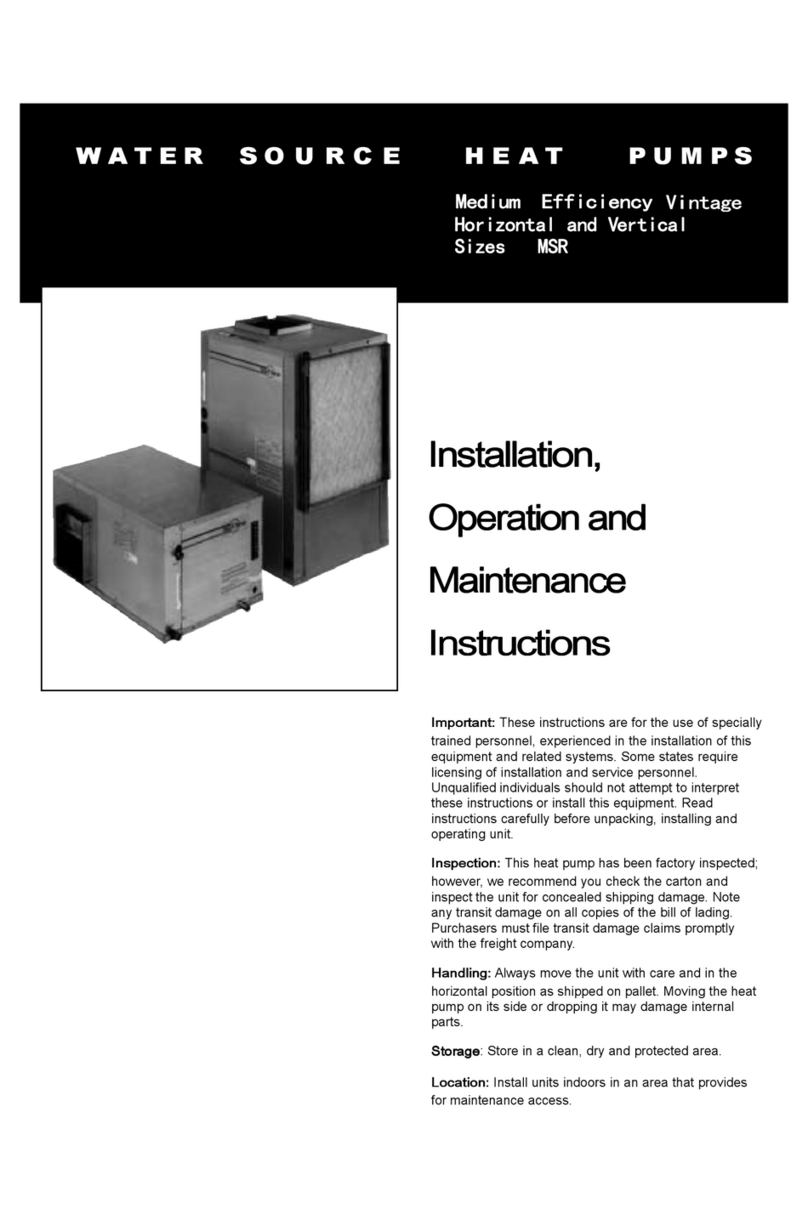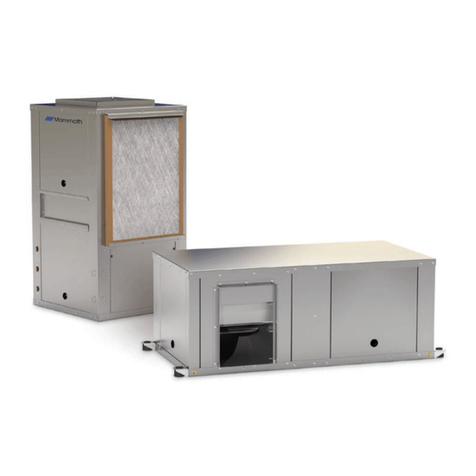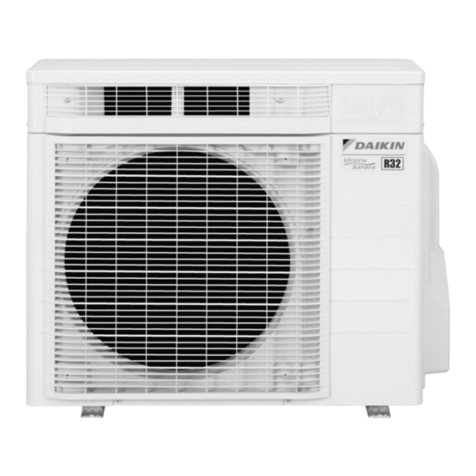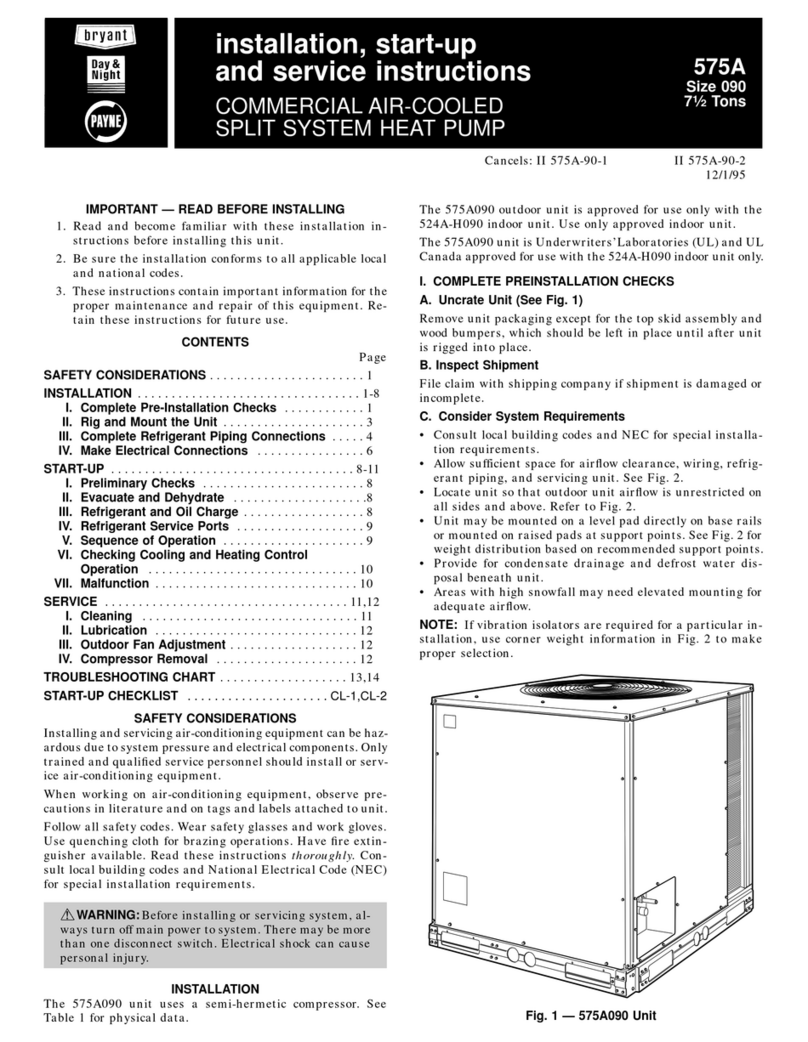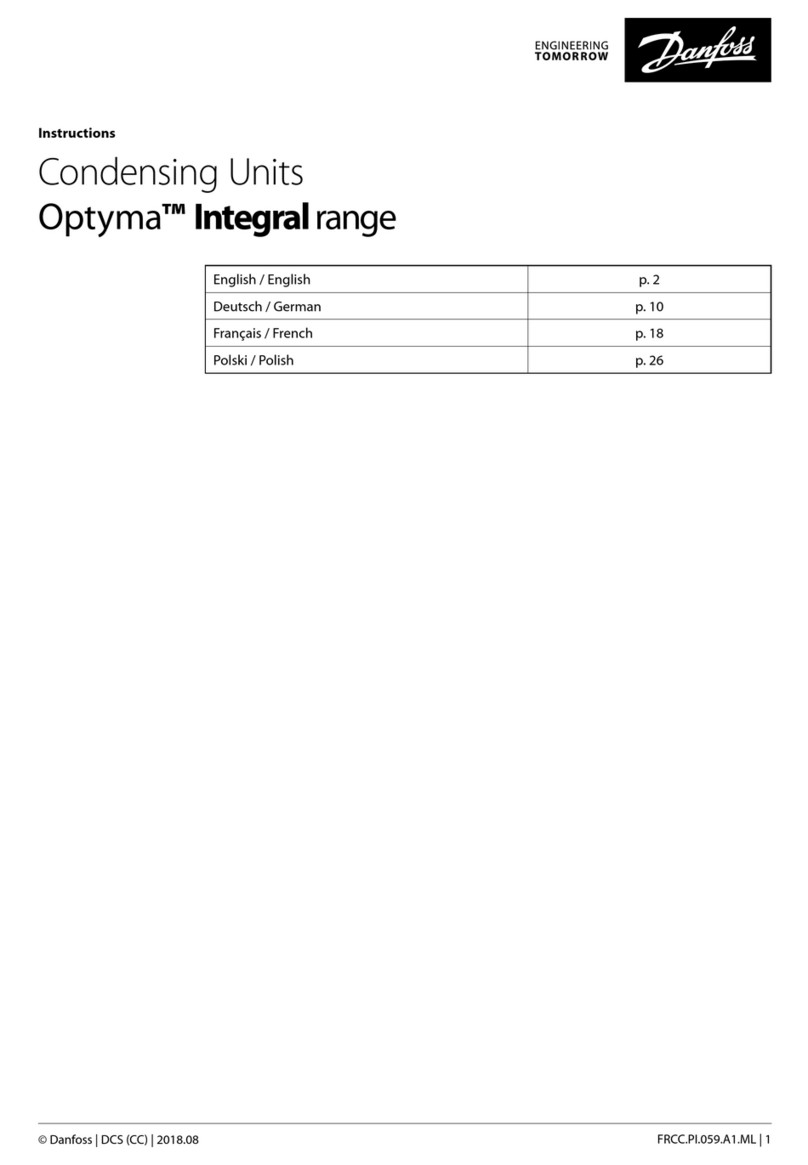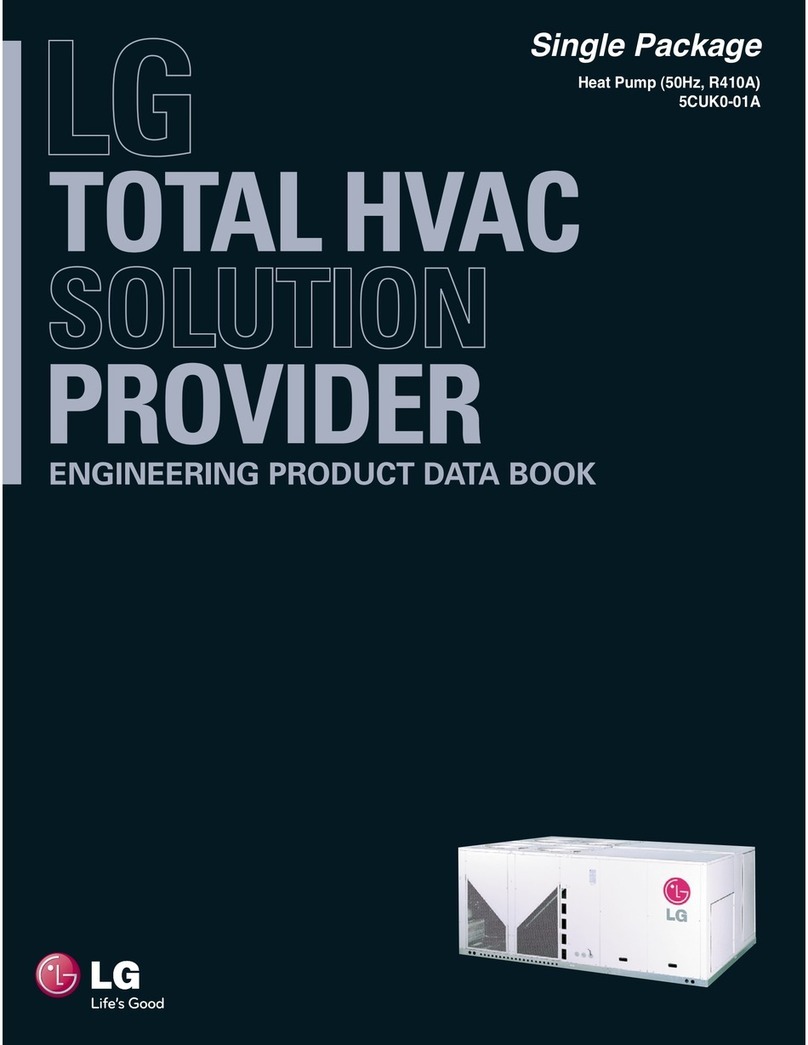Mammoth G-141-MHC Manual

Important: These instructions are for the use of
specially trained personnel, experienced in the
installation of this equipment and related system
components. Some states require licensing of
installation and service personnel. Unqualified
individuals should not attempt to interpret these
instructions or install this equipment. Read
instructions carefully before unpacking, installing and
operating this heat pump unit.
Inspection: This heat pump has been factory
inspected prior to shipment. Ho ever, e
recommend you check the carton before unloading
WATER SOURCE HEAT PUMPS
100 Percent Outside Air Units
Sizes 071 thru 381
Installation,
Operation
and Maintenance
Instructions
Mammoth Inc.
www.mammoth-inc.com
U 5
©1/2003 Mammoth Inc.
(P/N 71144921)
Mammoth is committed to a policy of
continuous.product improvements, and thus
reserves the right to.change specifications and
design ithout notice.
G - 141 - MHC
Voltage:
F = 208-230/60/3
G = 460/60/3
K = 575/60/3
J = 380/50/3
Unit Size (Nominal Cooling):
071 = 72,250 Btu/hr. cooling
111 = 111,000 Btu/hr. cooling
141 = 148,000 Btu/hr. cooling
181 = 183,000 Btu/hr cooling
221 = 226,000 Btu/hr cooling
271 = 270,000 Btu/hr cooling
321 = 330,000 Btu/hr cooling
381 = 381,000 Btu/hr cooling
Unit Type:
MHC = 100% Outside Air,
Standard Temperature Range
Design Series “C”
MLC = 100% Outside Air,
Low Temperature Geothermal,
Design Series “C”
and note any transit damage on all copies of the bill
of lading. Also inspect the unit for concealed shipping
damage after removing packaging. Transit damage
claims must be filed promptly ith the freight
company by the purchaser.
Handling: Al ays handle ith care and in the
horizontal position as shipped on the pallet. Moving
the heat pump on its side or dropping it may damage
internal parts.
Location: Unit must be installed indoors in any area
allo ing adequate room for mounting of unit and ith
access for maintenance and service.
Nomenclature

2 U-5 IOM
Installation
Definition
T in circuit 100% Outside Air unit ith one fan outlet
and t o independent refrigerant circuits.
Unit placement – ceiling hung
Mammoth’s 100% outside air heat pump can be
hung from the ceiling using the mounting rails
attached to the unit and ith vibration isolation
grommets shipped inside the unit’s electric
compartment.
1. Fit the grommets into the 3⁄4-inch diameter holes
on the mounting rails. Use 5⁄16-inch or 3⁄8-inch
threaded rods (supplied by others) to hang the
unit from the ceiling. Cover the entire bottom of
the 11⁄4-inch diameter grommet ith a asher
(supplied by others).
Figure 1. Ceiling-hung pla ement
Note: Never attempt to raise, lower or adjust the
pitch of the unit by turning the units on the hanger
rods without first taking the weight of the unit
completely off the vibration isolation grommets.
2. Mount the unit ith a 5-degree (maximum) pitch
to ard the condensate drain connection. Outside
air units are available ith an optional bottom drain
connection. In the ceiling-mounted arrangement
this option ill allo for more effective condensate
removal.
3. See unit data sheet for dimensional information.
Unit placement – slab mounted
Mammoth’s 100% outside air heat pump can also be
installed on a flat level surface. It is recommended
that vibration mounts be placed under the unit to
prevent transmission of vibrating to the building
structure. The standard side drain connection is
required in this arrangement.
See unit data sheet for further dimensional details.
Threaded Rod
(By Others)
Water Out
Water In
Low Voltage
Connection
Main Power
Connection
Mounting Rail Mounting Rail
See Grommet
Detail
GROMMET DETAIL
Threaded Rod
(By Others)
Mounting Rail
Vibration Isolation Grommet
Washer (By Others) Must Cover
Entire Bottom of Grommet
Retaining Nuts
(By Others)
Base
Condensate Connection

U-5 IOM 3
Du twork
Water supply
Fasten the supply duct ork to the collar provided.
Use a flexible duct connection bet een the unit and
the supply duct. Make sure the blo er heel turns
freely and is centered before making the connection.
If a return air is used, it may be fastened to the
flanges on the filter guides. Make sure there is easy
access for filter replacement.
The discharge or supply air duct should be insulated
and have at least on 90-degree bend prior to the first
discharge grille. Heat pump life expectancy and
efficiency depends on adequate airflo . For nominal
cfm information see unit data sheet.
The heat pump must not be operated ithout ater
flo ing through its ater-to-refrigerant heat
exchanger coils. Severe damage to the unit may
result.
For proper ater flo rates, refer to the unit
specification sheet.
Condensate drain
See Figures 2 and 3
The condensate drain is set up for 7⁄8-inch O.D.
copper connection. The condensate pipe or hose
installed must have a minimum 3-inch trap in the
condensate line. All condensate piping must pitch
Figure 2. Condensate trap detail – bottom drain
Bottom
of Unit
2-inch
Min.Trap
Figure 3. Condensate trap detail – side drain
3"
7/8" O.D.
Condensate
1.5-inch Min. Internal
Trap (By Others)
Appli ation limits
COOLING
STD. TEMP. LOW TEMP.
MINIMUM ENTERING WATER/BRINE 55 F 30 F
MAXIMUM ENTERING WATER 110 F 110 F
MINIMUM ENTERING AIR 60 F 60 F
MAXIMUM ENTERING AIR 100 F 100 F
HEATING
STD. TEMP. LOW TEMP.
MINIMUM ENTERING WATER/BRINE 50 F 25 F
MAXIMUM ENTERING WATER 90 F 90 F
MINIMUM ENTERING AIR 40 F* 40 F*
MAXIMUM ENTERING AIR 80 F 80 F
Only one maximum condition can exist at the same
time.
*Note: The minimum entering air temperature must
not fall below 40 .
If the outside air is cooler than 40 it must be
preconditioned or the unit must be shut off.
Mammoth offers both optional electric and hot water
preheat coils for this situation. See page 5 for
additional information on the heaters.
a ay from the unit for proper drainage by gravity and
as required by local codes. Condensate drains are
available as either standard side connection or
optional bottom connection.
Closed loop systems
1. Unit should be left unconnected or isolated using
gate valves as the building ater loop is initially
flushed.
2. Water system should be filled ith 1 lb. trisodium
phosphate for every 50 gallons of ater.
3. The piping should then be purged of trapped air,
supplemental heater set to maintain 110 F and the
solution circulated for approximately 8 hours.
4. The system should then be drained completely
and the entire flushing process repeated, if
necessary.
5. After completely cleaned and drained, fill loop ith
ater at an alkaline level of approximatelly pH 7.5.
6. Connect heat pump the the piping loop.
7. Make sure all entrained air is purged from loop.
Determine that specified flo rate through each
unit is established.

4 U-5 IOM
Electrical service and fuses
Warning: Turn off electrical power before servicing
controls. Severe electrical shock may result unless
power is turned off.
Unit must be installed in compliance with NEC and
local codes.
Route ires through a properly sized disconnect
s itch. Consult the iring diagrams that are found in
this manual and inside the cover of the electrical box
to complete the connection. see nameplate for proper
fuse sizing, minimum circuit ampacity and voltage
requirements. An auxiliary electrical heater must be
installed ith a po er supply separate from the heat
pump.
All factory installed electric preheat coils require a
separate po er supply. See the unit specification
sheet for more information.
Control wiring
All of the heat pump functions are controlled by
remote thermostat and must be ired as sho n,
using approved 18-gauge copper ire.
Ele tri supply
Changing filters
The filters can be accessed from either side of the
unit. The filter access panels (see Figure 4) are held
in place by several sheet metal scre s. After one of
the access panels have been removed the filters ill
slide out.
The same access panel that allo s access to the
standard 2-inch filters also allo s access to the
optional 4-inch thick panel filters.
Figure 4. A ess panels
Preheat Section
Filter Access Section
Optional hose kits
The flexible ater hoses are 2-foot stainless steel
hoses for ater connections to the heat pump and
adapters. Use t o properly sized renches, one on
the unit FPT fitting and one on the hexagonal fitting
on the hose, hen connecting hoses. Do not use
rench on hose or sleeve that crimps the fitting onto
the hose. Hoses must not be subjected to stress of
being pulled taut, t isted or kinked. Connections
should not be over tightened.
Before pressurizing the ater system, closely inspect
hoses and fittings to be sure there are no cuts,
abrasions, t ists, kinks, stretch and hoses ill not be
in contact ith any sharp surface or edge hile in
use. Also available for heat pumps is a condensate
hose and t o hose clamps.
For Mammoth hose kit information as to installation
and specifications, see data sheets C-91 and C-93.

U-5 IOM 5
Optional preheat se tion
The preheat section is located after the outside air
damper section and the filter section. It can be
access via access panels on either side of the heat
pump (see Figure 4).
Electric Preheat — Optional
The Mammoth 100% Outdoor Air unit provides
optional electric heat to preheat the outdoor air to a
point here efficient compressor heating can take
place.
The electric heater is a pre-assembled package
designed to be installed internal to the unit. The
elements are constructed of nichrome ire and
include thermal limits, duct high limit, air proving
s itch, and nonfused disconnect s itch. The heater
operation is determined by outside air temperature, to
maintain a minimum 40 F entering air temperature to
the airside coil.The minimum entering air temperature
to the air coil is 40 F to allo operation of the
mechanical refrigeration for heating.
Figure 5. Optional preheat wiring diagram
The heater includes its o n control box separate
from the unit’s electrical panel. It is mounted on the
outside of the unit casing, hich houses all the heater
control components and safety devices. The heater is
U.L. listed. A separate po er source from the unit is
required.
Hot Water Preheat — Optional
The Mammoth 100% Outdoor Air unit provides
optional hot ater coils to preheat cold outdoor air to
a point here efficient compressor heating can take
place.
The hot ater coil is constructed of aluminum fins
bonded to seamless copper tubes.
Units ith the optional temperature control system
include a t o- ay, t o-position, spring return valve
actuator. The valve actuator is controlled to maintain
a minimum 40 F entering air temperature to the air
coil to allo operation of the mechanical refrigeration
for heating. A freezestat closes the outdoor air
dampers and stops the fan and compressor if mixed
air is belo 33 F.

6 U-5 IOM
Figure 6. 100% outside air unit wiring diagram
208/230 or 460 VOLTS
60 HERTZ, 3 PHASE
SEE NOTE 2
CIRCUIT #1
COOLING ONLY (FIRST STAGE)
WITH HOT GAS REHEAT
(DEHUMIDIFICATION)
F
SEC
#1
COMPRESSOR
T3 T1
T2
T3 T2 T1
L3 L2 L1 1M
L3
L2
L1
POWER
BLOCK
50 VA
TRANSFORMER
24 VAC
75 VA
TRANSFORMER
24 VAC
TERMINAL
STRIP
24 VAC
COMPRESSOR #1
COMPRESSOR #2
FAN
REVERSING VALVE (CIRCUIT #2)
RESET LIGHT
DEHUMIDIFICATION (CIRCUIT #1)
C1
R
PINK/BLACK STRIPE
Y1
Y2
G
O
L
H
E
C2
1
2
BLUE
YELLOW
BLUE
PINK
BLACK
PURPLE
ORANGE
PINK/BLACK STRIPE
#1
#2
SEE NOTES
1, 4 & 5
SEE NOTES
1, 4 & 5
BLACK
BLACK
BLACK
YELLOW
BLUE
1R
31
45
2
CS
LP
HP

U-5 IOM 7
CIRCUIT #2
FIRST STAGE HEATING
COND STAGE COOLING
#2
COMPRESSOR
T3 T1
T2
T3 T2 T1
L3 L2 L1 2M
BLACK
BLACK
BLACK
BLOWER
MOTOR
96
95
T2
BLACK
BLACK
BLACK
3
45
SEE NOTE 6
SEE NOTE 3
WT
HP
CS
LP
6
12
3
C1 C2
4R
2R
TD
HR
RV
CIRCUIT #2
CIRCUIT #1
31
45
2
1
5
42
T3 T1
L3 L2 L1 3M
S3
S1
1
2
RS
DM
3R
NOTES:
1. All units are factory- ired to customer order.
For 208 volt units, use the black and red transformer leads.
For 230 volt units, use the black and orange transformer leads.
For 460 volt units, use the black and black/red strip transformer leads.
2. Supply iring must have copper conductors.
3. An external manual reset overload is used on all 5 HP through 20 HP blo er
motors. All other blo er motors have internal auto reset overloads.
4. Insulate all unused ire ends.
4. Both transformers must be phased identically: L1 is al ays the transformer’s black
lead.
5. The optional “Water Temperature S itch” (WT) is also included in the optional “Lo
Temperature Package” (TL).
LEGEND:
Ground
Compressor Contactor (Circuit #1)
Compressor Contactor (Circuit #2)
Blower Contactor
Lockout Relay (Circuit #1)
Lockout Relay (Circuit #2)
Hot Gas Reheat Relay (Circuit #1)
Cooling Relay (Circuit #2)
Hot Gas Reheat Valve (Circuit #2)
Reversing Valve (Circuit #2)
HP High Pressure Switch (400 psi)
LP Low Pressure Switch (7 psi)
CS Condensate Switch (Optional)
WT Water Temperature Switch (32 F)
Optional (Circuit #2)
DM Damper Motor
OL Overload Relay (See Note 2)
RS Random Start Relay (25-60 Seconds)
TD Time Delay Relay (25-60 Seconds)
1M
2M
3M
1R
2R
3R
4R
HR
RV
Control Voltage Factory Wiring (24 VAC)
Control Voltage Field Wiring (24 VAC)
Line Voltage Factory Wiring
Line Voltage Field Wiring

8 U-5 IOM
Figure 7. 100% outside air unit with hot water preheat wiring diagram
208/230 or 460 VOLTS
60 HERTZ, 3 PHASE
SEE NOTE 2
COOL
WI
(D
L3
L2
L1
POWER
BLOCK
BLACK
50 VA
TRANSFORMER
24 VAC
3
5
2
1
4
WHITE
YELLOW
BLUE
BLUE
PINK
PINK/BLACK STRIPE
PURPLE
ORANGE
BLACK
PINK/BLACK STRIPE
1
2
D
Y1
Y2
R
G
C1
L
H
O
C2
DEHUMIDIFICATION
COMPRESSOR #1
COMPRESSOR #2
FAN
24 VAC
LOCKOUT ALARM
HOT GAS REHEAT
REVERSING VALVE
RV
5R
C2 C1
5
3
4
1
2
6
CIRCUIT #2
CIRCUIT #1
HV
7R

U-5 IOM 9
CIRCUIT #1
LING ONLY (FIRST STAGE)
TH HOT GAS REHEAT
DEHUMIDIFICATION)
CIRCUIT #2
1ST STAGE HEATING
2ND STAGE COOLING
#1
COMPRESSOR
L3 L3
L1 L1
L2 L2
T3 T3
T3
T2 T2
T2
T1 T1
T1
L3 L3
L3
L2 L2
L2
L1 L1
L1
1M 2M
3M
#2
COMPRESSOR
BLOWER
MOTOR
96
95
SEE NOTE 3 OL
WT
CS
CS
HP
HP
LP
LP
TD
BLACK
75 VA
TRANSFORMER
24 VAC
LTC
SEE NOTE 6 (240 SECONDS)
4
25
3
1
4R
RPB ADT
M1 LINE
CN.C.
3
3
1
1
6R
C1 C2
2
6
5
3R
31
11
5
55
2
22
1
RS S3
33
S1
1
2
DM
44
1R 2R
SEE NOTE 4
NOTES:
1. All units are factory- ired to customer order.
For 208 volt units, use the black and red transformer leads.
For 230 volt units, use the black and orange transformer leads.
For 460 volt units, use the black and black/red strip transformer leads.
2. Supply iring must have copper conductors.
3. An external manual reset overload is used on all 5 HP through 20 HP blo er motors. All other blo er motors have internal auto reset overloads.
4. The optional “Water Temperature S itch” (WT) is also included in the optional “Lo Temperature Package” (TL).
5. Both transformers must be phased identically: L1 is al ays the transformer’s black lead.
6. If “Lo Temperature Cutout S itch” (P/N 71042410) is factory set at 33 F. Its bulb is positioned across the discharge side of the preheat coil.
7. Insulate all unused ire ends.
Ground
Compressor Contactor (Circuit #1)
Compressor Contactor (Circuit #2)
Blower Contactor
Lockout Relay (Circuit #1)
Lockout Relay (Circuit #2)
Lockout Signal Relay
Hot Gas Reheat Relay (Circuit #1)
Cooling Relay (Circuit #2)
Low Temperature Lockout Relay
Dehumidification Lockout in Heating Mode Relay
Hot Gas Reheat Valve (Circuit #1)
4-Way Reversing Valve (Circuit #2)
HP High Pressure Switch (400 psi)
LP Low Pressure Switch (7 psi)
CS Condensate Switch (Optional)
WT Water Temperature Switch (Optional)
RS Random Start Relay (25-60 Seconds)
TD Time Delay Relay (25-60 Seconds)
LTC Low Temperature Cutout
RPB Reset Push Button
ADT Adjustable Delay-on-Make Timer
DM Damper Motor
OL Overload (See Note 3)
1M
2M
3M
1R
2R
3R
4R
5R
6R
7R
HR
RV
Control Voltage Factory Wiring (24 VAC)
Control Voltage Field Wiring (24 VAC)
Line Voltage Factory Wiring
Line Voltage Field Wiring
LEGEND:

10 U-5 IOM
Figure 8. 100% outside air unit with Johnson Metasys ontrols and ele tri preheat wiring diagram
2
1 345678 6543
21 3456
10V
2V OFF
OFF
T
V
ANALOG INPUTS
BINARY OUTPUTS
BINARY
INPUTS
AI COM
AI COM
AI COM
AI COM
AI COM
AI COM
15 VDC
24 VAC
24 VAC
24 VAC
24 VAC
24 VAC
24 VAC
TRIACS
COMMON
COMMON
COMMON
COMMON
COMMON
AI 1
AI 2
AI 3
AI 4
AI 5
AI 6
15 VDC
B11
B12
B13
B14
24 VAC
COM
REF
N2–
N2+
ZBUS
BO 1
BO 2
BO 3
BO 4
BO 5
BO 6
BO 7
BO 8
SEE NOTE 6
P5 P6
Z BUS
SEE NOTE 9
TO
ZONE
STAT
JOHNSON CONTROLS, INC.
METASYS
MODEL AS-UNT110-1
(10 VA POWER REQUIREMENT)
21
ON
MA
HS
OT
DA
AF
(SET @ 0.25")
SEE NOTE 4
(BETWEEN THE ELECTRIC PRE-
HEAT AND EVAPORATOR COILS)
(ON THE RETURN AIR DUCT FLANGE
UPSTREAM OF THE AIR DAMPERS)
(IN THE DISCHARGE AIR DUCTWORK)
(IN THE DISCHARGE AIR DUCTWORK)
OUT COM
POWER
TEMP TEMP
RED YELLOW
TERMINAL
STRIP
1
2
E
Y1
Y2
R
G
C1
H
L
O
C2
YELLOW
BLUE
BLUE
PINK
PINK/BLACK STRIPE
ORANGE
PURPLE
BLACK
PINK/BLACK STRIPE
208/230 OR
460 VOLTS
60 HERTZ
3 PHASE
SEE NOTE 2
ELECTRIC
PREHEAT CONTROLS
2C 1
RED
BLACK
WHITE
SEE NOTE 10
22
55
44
1133
7R 6R
GRAY
PINK/BLACK STRIPE
WHITE
L3
L2
L1
50 VA
TRANSFORMER
24 VAC
BLACK
SEE NOTES
1, 8 & 11
YELLOW
BLUE
5R
31
5
24
RV
SEE NOTE 5
#2

U-5 IOM 11
CIRCUIT #1
COOLING ONLY (1ST STAGE)
WITH HOT GAS REHEAT
(DEHUMIDIFICATION)
CIRCUIT #2
1ST STAGE HEATING
2ND STAGE COOLING
#1
COMPRESSOR #2
COMPRESSOR
T3 T3
T2 T2
T1
T1 T1
T1
T1
T3 T3
T3
T2 T2
T2
L3 L3
L3
L2 L2
L2
L1 L1
L1
1M 2M
SEE NOTE 7
TRANSFORMER
24 VAC
75 VA
BLACK
SEE NOTES
1, 8 & 11
YELLOW
BLUE
3R
3
1
52
4
HV
31
5
2 4
4R
1R
TD
2R
33
11
55
44
22
LP LP
CS CS
HP HP
WT 3M
RS S3
S1
1
2
DM
BLOWER
MOTOR
95
96
SEE NOTE 3 OL
2#1
NOTES:
1. All units are factory- ired to customer order.
For 208 volt units, use the black and red transformer leads.
For 230 volt units, use the black and orange transformer leads.
For 460 volt units, use the black and black/red strip transformer leads.
2. Supply iring must have copper conductors.
3. An external manual reset overload is used on all 5 HP blo er motors. All other blo er motors have auto reset overloads.
4. Both the HS and OT sensors are contained ithin one device.
5. JCI Metasys UNT110-1 uses a factory installed program.
6. This factory ired jumper bet een terminals BI1 and 24 VAC indicates occupied status.
7. The optional “Water Temperature S itch” (WT) is also included in the optional “Lo Temperature Package” (TL).
8. Both transformers must be phased identically: L1 is al ays the transformer’s black lead.
9. Johnson Controls, Inc. supplied jumper ire. Remove this jumper ire only if using a separate load transformer (by others).
10. The use of three-conductor shielded cable is required bet een relays 6R and 7R and the electric preheat control panel’s terminal block.
11. Insulate all unused ire ends.
Ground
Compressor Contactor (Circuit #1)
Compressor Contactor (Circuit #2)
Blower Contactor
Lockout Relay (Circuit #1)
Lockout Relay (Circuit #2)
Lockout Signal Relay
Hot Gas Reheat Relay (Circuit #1)
Cooling Relay (Circuit #2)
Stage #1 Electric Preheat Relay (PE)
Stage #2 Electric Preheat Relay (PE)
Hot-Gas Reheat Valve (Circuit #1)
4-Way Reversing Valve (Circuit #2)
HP High Pressure Switch (400 psi)
LP Low Pressure Switch (7 psi)
CS Condensate Switch (Optional)
WT Water Temperature Switch (Optional)
RS Random Start Relay (25-60 Seconds)
TD Time Delay Relay (25-60 Seconds)
DM Damper Motor
OL Overload (See Note 3)
AF Airflow Sensor
DA Discharge Air Sensor
HS Humidistat (See Note 4)
MA Mixed Airflow
OT Outdoor Thermostat (See Note 4)
1M
2M
3M
1R
2R
3R
4R
5R
6R
7R
HV
RV
Control Voltage Factory Wiring (24 VAC)
Control Voltage Field Wiring (24 VAC)
Line Voltage Factory Wiring
Line Voltage Field Wiring
LEGEND:

21 345678 6543
21 3456
10V
2V OFF
OFF
T
V
ANALOG INPUTS
BINARY
INPUTS
SEE NOTE 6
P5 P6
Z BUS
TO
ZONE
STAT
JOHNSON CONTROLS, INC.
METASYS
MODEL AS-UNT110-1
(10 VA POWER REQUIREMENT)
21
ON
MA
SEE NOTE 4
(BETWEEN THE ELECTRIC PRE-
HEAT AND EVAPORATOR COILS)
SEE NOTE 5
AI COM
AI COM
AI COM
AI COM
AI COM
AI COM
15 VDC
24 VAC
24 VAC
24 VAC
24 VAC
AI 1
AI 2
AI 3
AI 4
AI 5
AI 6
15 VDC
B11
B12
B13
B14
24 VAC
COM
REF
N2–
N2+
ZBUS
HS
OT
DA
AF
(SET @ 0.25")
(ON THE RETURN AIR DUCT FLANGE
UPSTREAM OF THE AIR DAMPERS)
(IN THE DISCHARGE AIR DUCTWORK)
(IN THE DISCHARGE AIR DUCTWORK)
OUT COM
POWER
TEMP TEMP
RED YELLOW
BINARY OUTPUTS
24 VAC
24 VAC
TRIACS
COMMON
COMMON
COMMON
COMMON
COMMON
BO 1
BO 2
BO 3
BO 4
BO 5
BO 6
BO 7
BO 8
TERMINAL
STRIP
1
2
E
Y1
Y2
R
G
C1
H
L
O
C2
YELLOW
BLUE
BLUE
PINK
PINK/BLACK STRIPE
ORANGE
PURPLE
BLACK
PINK/BLACK STRIPE
RV
208/230 OR
460 VOLTS
60 HERTZ
3 PHASE
SEE NOTE 2
L3
L2
L1
50 VA
TRANSFORMER
24 VAC
BLACK
SEE NOTES
1, 8 & 11
YELLOW
BLUE
#
5R
24
31
5
12 U-5 IOM
Figure 9. 100% outside air unit with Johnson Metasys ontrols and hot water preheat wiring diagram
NOTES:
1. All units are factory- ired to customer order.
For 208 volt units, use the black and red transformer leads.
For 230 volt units, use the black and orange transformer leads.
For 460 volt units, use the black and black/red strip transformer leads.
2. Supply iring must have copper conductors.
3. An external manual reset overload is used on all 5 HP blo er motors. All other blo er motors have auto reset overloads.
4. Both the HS and OT sensors are contained ithin one device.
5. JCI Metasys UNT110-1 uses a factory installed program.
6. This factory ired jumper bet een terminals BI1 and 24 VAC indicates occupied status.
7. The optional “Water Temperature S itch” (WT) is also included in the optional “Lo Temperature Package” (TL).
8. Both transformers must be phased identically: L1 is al ays the transformer’s black lead.
9. Johnson Controls, Inc. supplied jumper ire. Remove this jumper ire only if using a separate load transformer (by others).
10. The “Lo Temperature Cutout” s itch (P/N 71042410) is factory set at 33 F. Its bulb is positioned across the discharge side of the preheat coil.
11. Insulate all unused ire ends.

RTRANSFORMER
24 VAC
75 VA
BLACK
SEE NOTES
1, 8 & 11
YELLOW
BLUE
#2 #1
CIRCUIT #1
COOLING ONLY (1ST STAGE)
WITH HOT GAS REHEAT
(DEHUMIDIFICATION)
CIRCUIT #2
1ST STAGE HEATING
2ND STAGE COOLING
#1
COMPRESSOR #2
COMPRESSOR
T3 T3
T2 T2
T1
T1 T1
T1
T3 T3
T2 T2
L3 L3
L2 L2
L1 L1
1M 2M
SEE NOTE 7
T1
T3 T2
L3 L2 L1
WT 3M
BLOWER
MOTOR
95
96
SEE NOTE 3 OL
1R
TD
2R
33
11
55
44
22
LP LP
CS CS
HP
HP
4R
3
2
4
3R
1
5
HV
LTC RPB ADT
3
3
1
1
5
5
2
2
4
4
RS S3
S1
1
2
DM
6
6R
C1
C
C2
N.C.
31
(240 SECONDS)
SEE NOTE 10
M1 LINE
U-5 IOM 13
Ground
Compressor Contactor (Circuit #1)
Compressor Contactor (Circuit #2)
Blower Contactor
Lockout Relay (Circuit #1)
Lockout Relay (Circuit #2)
Lockout Signal Relay
Hot Gas Reheat Relay (Circuit #1)
Cooling Relay (Circuit #2)
Low Temperature Lockout Relay
Stage #2 Electric Preheat Relay (PE)
Hot-Gas Reheat Valve (Circuit #1)
4-Way Reversing Valve (Circuit #2)
HP High Pressure Switch (400 psi)
LP Low Pressure Switch (7 psi)
CS Condensate Switch (Optional)
WT Water Temperature Switch (Optional)
RS Random Start Relay (25-60 Seconds)
TD Time Delay Relay (25-60 Seconds)
DM Damper Motor
OL Overload (See Note 3)
AF Airflow Sensor
DA Discharge Air Sensor
HS Humidistat (See Note 4)
MA Mixed Air Sensor
OT Outdoor Thermostat (See Note 4)
LTC Low Temperature Cutout
ADT Adjustable Delay-on-Make Timer
1M
2M
3M
1R
2R
3R
4R
5R
6R
7R
HV
RV
Control Voltage Factory Wiring (24 VAC)
Control Voltage Field Wiring (24 VAC)
Line Voltage Factory Wiring
Line Voltage Field Wiring
LEGEND:

Optional temperature
ontrol
Sequen e of operation
Johnson Metasys
Mammoth’s 100% Outdoor Air heat pump units offer
three choices of temperature control:
1. An optional Mammoth DDC control system for
complete unit control. Wiring diagrams and startup
information for the MDDC controller is not provided
in this document. Each MDCC controller has an
individual Installation and Operation Manual
created for it. Contact Mammoth for more details.
2. A Johnson Metasys DDC controller that can be
used as a stand-alone controller or ith a Johnson
Metasys BMS.
Several typical iring diagrams have been
provided for this option (Figure 8 and Figure 9).
Startup information for the Johnson Metasys
controller is provided on page 15.
3. Temperature control by others hich includes a
24-volt terminal strip for connection of a controller
to operate the compressors, fan motor, reversing
valve and reheat valve.
Several typical iring diagrams have been
provided for this option (Figure 6 and Figure 7).
Consult the factory for a specific diagram. Startup
for controls by others is not provided in this
document. It is not common but it is possible to
operate a 100% OA unit using a thermostat ith
humidity control (by others). Startup instructions
are provided on page 15.
14 U-5 IOM
The Metasys control system is can be tied in to a
Metasys Building Automation System or it can be an
independent, stand-alone control system. The
system includes:
●Outdoor air temperature sensor
●Mixed air temperature sensor
●Outdoor air humidity sensor
●Discharge air temperature sensor
●Cooling control from outdoor air and humidity
sensors
●Heating control from discharge air sensor
●Reheat control for discharge air
●Neutral discharge air temperature
●Fan operation from damper end s itch
●Adjustable temperature/humidity set points
●Adjustable differential for heating, cooling
●Spring return outdoor damper actuator ith end
s itch
●Air proving s itch
●Optional Zone Terminal for field modification of set
points on stand-alone controls.
On a call for unit operation, the outdoor air damper
ill open. The controller ill first examine the mixed
air temperature. If the outdoor air is belo the set
point of the mixed air sensor, the preheat ill be
energized to increase the air temperature. When the
damper is fully open, the fan ill run continuously.
After the need for preheat is examined, the controller
then looks at the need for compressor cooling. If the
outdoor air is above the first stage cooling set point,
then the first stage compressor ill operate in the
cooling mode. If the outdoor air humidity is above the
set point, the controller ill energize stage one
cooling operation. On a further increase in outdoor
temperature, the second stage-cooling compressor
ill be energized.
If the discharge air temperature is belo the set point
(55 F and adjustable), the hot gas reheat valve ill
be activated to provide hot refrigerant gas to the
reheat coil to increase the discharge air temperature.
If the discharge air temperature rises above the set
point of the discharge air temperature, the hot gas
reheat valve ill be de-activated. If the outdoor air
temperature falls belo the second stage cooling
control set point, the second stage cooling ill be de-
activated.
If the outdoor air humidity falls belo the outdoor air
humidity set point, first stage cooling ill remain on
until the outdoor air temperature is belo the first
stage cooling set point. The first stage cooling ill
remain on until the outdoor air humidity and
temperature are belo their set points.
If the outdoor air temperature falls belo the first
stage heating set point, the compressor ill operate
in the heating mode. If the mixed air temperature falls
belo the preheat set point (40 F and adjustable),
the optional preheat coil ill be activated to provide
heating. If the mixed air temperature rises above the
set point, the preheat ill be de-activated. If the
discharge temperature rises above the set point, the
compressor heating ill be de-activated.
Figure 10. Metasys ontrol points
and unit s hemati
Outdoor Air Temp. Sensor
Damper Section Fan/Motor Section
Airflow
Airflow
Mixed Air Temp. Sensor
Outdoor Air Humidity Sensor Discharge Air Temp. Sensor
T
H
M
D
Preheat
DX Coil
Hot Gas Reheat
Filters

U-5 IOM 15
Operation
Startup using Mammoth DDC controls
Consult the factory for specific instructions for your
unit.
Startup with factory mounted
Johnson Metasys controls
1. Turn po er on.
2. The green light on the Johnson Metasys UNT
DDC controller should blink.
3. The outside air damper ill open.
4. When the damper has opened 60-75%, the fan
ill start.
5. Unit ill operate according to the mixed air
temperature. If the mixed air temperature is
above the set point of the controller, the unit ill
cool. If the outdoor air temperature is belo the
set point of the controller, the unit ill heat. Only
the fan ill run if the mixed air is in the dead
band of the set points.
6. Plug the ZT (Zone Terminal) into the UNT
controller using the supplied phone cord. The
inputs listed on the left side of the ZT can be
monitored. The binary outputs are listed on the
right side of the ZT. A hash mark indicates a call
for that particular output to operate. Zone
Terminal controller is available as Mammoth part
number 73399930.
7. The adjustable set points are: Occupied Cooling,
Occupied Heating, Unoccupied Cooling and
Unoccupied Heating. To adjust the set point,
open the access cover on the bottom of the ZT
and push the button to the left of the four LEDs
(Monitor, Adjust, Time Schedule and Pass ord)
until the adjust LED is lit. Adjust the set point up
or do n ithin the program limitations using the
up and do n arro s. Your set point ill appear
next to the Actual Clg Set and Actual Htg Set.
8. While the unit is operating in the cooling mode
ith both compressors, adjust the ater flo to
obtain a 12 F temperature rise in the leaving
ater temperature as compared to the entering
ater temperature.
Note: Set point adjustment in #7 above may be
required to get both compressors on.
9. Check for clean filters. Replace if necessary.
10. The unit is ready for continuous operation.
Note: Minimum dry bulb temperature drop between
supply and return airstreams should be about 16 . a
water temperature rise of 12-25 could be
anticipated at relatively low water flow rates.
Startup using thermostat
A special thermostat (supplied by others) ill be
required for humidity control.
After installing the unit, connecting duct ork ater,
condensate lines and the iring as described in the
preceding instructions, the unit is ready for startup.
Check all ire connections in the unit and to the
external control devices
Make certain that the thermostat system s itch is in
the “OFF” position and the fan s itch is in the
“AUTO” position. Also, the electric box cover and
access panels should be mounted in place. Then turn
on the po er to the unit.
Turn the thermostat fan s itch to the “ON” position.
The unit blo er should operate.
Note: Unit may not start for 2-5 minutes due to usage
of random start relays and/or anti-short cycle relays.
1. Check the airflo and make sure no supply grilles
or duct dampers are closed to restrict airflo .
2. Set the thermostat temperature setting lo and
turn the system s itch to the heating mode.
3. Increase the temperature setting lo and turn the
system s itch to the heating mode.
4. After operating the unit for approximately ten
minutes, check the air temperature rise bet een
supply and return airstreams. The minimum
temperature rise should be about 18 F.
5. Using a surface pyrometer or other device, check
the temperature of the entering and leaving ater
temperatures at the unit. The recommended ater
temperature drop bet een entering and leaving
ater may range from 5 to 9 F at 45 F entering
ater temperature (ENT) and from 8 to 15 F at
70 F EWT.
If any of the above conditions do not exist, one or
more of the follo ing problems exist: lo airflo , lo
ater flo or unit not performing properly (contact
service department for assistance.
Next set the thermostat system s itch to cooling
mode and reduce temperature setting gradually until
unit starts. After operating the unit for a fe minutes,
check if unit is functioning properly and providing
satisfactory cooling.
Note: Minimum dry bulb drop between supply and
return airstreams should be about 16 . A water
temperature rise of 12 to 25 could be anticipated at
relatively low water flow rates.

16 U-5 IOM
Maintenan e
Mammoth 100% Outside Air units may require more
frequent maintenance than standard ater source
heat pumps.
Air filters
Do not operate the heat pump unit ithout an air
filter. Clean the filters as often as necessary or at
least once every three months and more frequently in
dusty or other unclean environments.
Note: Dirty filters will cause inefficient heat pump
performance.
Air coil and blower wheel
Check the air coil and blo er heel at least once
each year. More frequent cleaning of blo er and heat
transfer surfaces may be required in locations ith
dirty air to maintain airflo and peak operating
performance. Clean as often as necessary.
Caution: Disconnect electric power supply to heat
pump before removing cabinet access panels.
Compressor
The 100% Outdoor Air heat pumps have been
designed ith s itches that protect the unit’s
refrigerant system if refrigerant pressure exceeds
either high or lo limits. If unsuitable pressure
occurs, the compressors ill automatically shut
do n. (Some thermostats ill indicate a compressor
shutdo n ith a “reset” light.)
If the compressor shuts do n, turn the controller
system s itch to the “OFF” position. After
approximately 10 minutes turn the controller system
s itch to “ON” and restart the unit. If the compressor
shuts do n again after only brief operation, a
problem exists and qualified service personnel must
be called to provide service.
General service
Any repair or service on the unit may be performed
only by qualified service personnel.
Warranty
Mammoth’s Standard Limited Warranty on all Water
Source Heat Pumps ill be in effect for the first 12
months after startup or 18 months from actual
shipment if no startup date is provided. Extended
arranties are also available for an additional charge.
Parts
Parts can be ordered from:
Mammoth Inc.
101 West 82nd Street
Chaska, MN 55318
Phone: (952) 361-2711
Fax: (952) 361-2629

U-5 IOM 17
Guidelines for refrigerant ir uit diagnosis
Normal Conditions
Subcooling: 10 to 12 F
Superheat: 8 to 12 F
Discharge: 140 to 150 F
Head Pressure: 210#
Suction Pressure: 70#
Evap. Temperature: 38 to 55 F, or 10-20 F belo
leaving air temperature
Over Charged Unit
Subcooling: 20 to 25 F
Superheat: 8 to 12 F
Discharge: 120 to 130 F
Head Pressure: 220# or higher than normal
Suction Pressure: 80# or higher than normal
Under Charged Unit
Subcooling: 6 to 8 F or lo er than normal
Superheat: 25 to 30 F or higher than
normal
Discharge: Over 200 F
Head Pressure: 180# or lo er than normal
Suction Pressure: 25# if lost a lot of refrigerant
Other: Lo er than normal evaporative
temperature
Plugged Thermal Expansion Valve
Subcooling: 15 to 20 F or higher than
normal
Superheat: 25 to 30 F or higher than
normal
Discharge: +200 F or armer than normal
Head Pressure: 250# or higher than normal
Suction Pressure: 45# or lo er than normal
Other: May have frost on air coil
May have high leaving air
temperature
The air coil may not be et
Low Evaporator Temperature
●Undercharged.
●Poor refrigerant distribution.
●Lo airflo (clogged filter or air coil).
●Excess oil in refrigerant air bypassing the coil.
●Damaged fins on the coil or poor fin-to-tube bond.
Subcooling in Cooling Mode
●Subcooled refrigerant is found after the coax and
before the TXV.
●The liquid line is almost al ays subcooled.
●The liquid line should be several degrees colder
than the leaving ater temperature.
●Superheated refrigerant is found after the air coil
and before the compressor.
●Superheated refrigerant is found after the
compressor and before the coax.
High Suction Superheat
●Under-charged refrigerant circuit.
●Poorly adjusted TXV — open it.
●Plugged TXV.
●High entering air temp in the cooling mode.
Poorly insulated suction line.
Low Suction Superheat
●Over-charged refrigerant circuit.
●Poorly adjusted TXV — close it.
●Lo entering air temp in the cooling mode.
●Lo airflo in the cooling mode.
Discharge Superheat
●High discharge superheat:
High suction superheat
Compressor lubrication problems
Compressor electrical problems
●Lo discharge superheat:
Lo suction superheat
Flooding-back

18 U-5 IOM
Pro edure for belt tensioning
Instructions
Set tension of ne drives at the maximum deflection
force recommended. Check tension at least t ice
during the first day of operation, since there ill
normally be a rapid decrease in belt tension until
belts have run in. Check tension periodically after the
first day of operation and keep tension in
recommended range. The correct operating tension
for a V-belt drive is the lo est tension at hich the
belts ill not slip under peak load conditions. Shafts
must be adequate for the tensions required.
To determine lbs. force required to tension a drive
ith belt tensioner, do the follo ing:
1. Measure belt span as sho n (Figure 11).
2. Divide belt span by 64 to get belt deflection.
3. Set large “O” ring on “span scale” at required belt
deflection. This scale is in 1⁄16 inch (1.6 mm)
increments.
4. Set small “O” ring at zero on “force scale”
(plunger).
5. Place larger end of tension tool squarely on one
belt at center of belt span. Apply force on plunger
until the bottom of the large “O” ring is even ith
the top of the next belt or ith the bottom of a
straightedge laid across the sheaves.
BELT SPAN
DEFLECTION = BELT SPAN
64
Figure 11. Belt defle tion
Table 1. Super Gripbelts
Figure 12.
Small
"O" Ring
Large
"O" Ring
SPAN SCALE FORCE SCALE
Belt Tension
Checker
6. Read force scale under the small “O” ring to
determine the force required to give the needed
deflection
7. Compare the force scale reading ith the correct
value for the belt style and cross section used as
given in Table 1. The force should be bet een the
minimum and maximum values sho n.
8. If there is too little deflection force, tighten belts. If
there is too much deflection force, loosen belts.
Example
1. Belt span is 64 inches (152 cm). Small sleeve has
a 6-inch (152 mm) pitch diameter ith “B” Super
Gripbelts.
2. Sixty-four inch ÷ 64 = 1 inch (25 mm) deflection
needed.
3. Set large “O” ring at 1 inch (25 mm) on span
scale.
4. Set small “O” ring at zero plunger.
5. Press do n on plunger until bottom of large “O”
ring is even ith top of next belt in set, or ith
bottom of a straightedge.
6. Check lbs. force required for a 1-inch (25 mm)
deflection of belt.
7. Super Gripbelt table (belo ) sho s a “B” belt used
ith 6-inch (152 mm) pitch diameter. Small sheave
should have a deflection force bet een 6 lbs. 6
oz. (2.89 kg) and 8 lbs. 8 oz. (3.97 kg).
8. Increase or decrease tension on belts until
deflection force lies in the required range.
BELT CROSS SMALLEST RPM DEFLECTION FORCE (LBS.)
SECTION SHEAVE SUPER GRIPBELTS GRIPNOTCH BELTS
UNNOTCHED BRANDS NOTCHED BRANDS
4.4 –5.6 860 –2500 5.3 7.9 7.1 10.5
2501 –4000 4.5 6.7 7.1 9.1
B, BX
5.5 –8.6 860 –2501 6.3 9.4 8.5 12.6
2501 –4001 6.0 8.9 7.3 11.9

U-5 IOM 19
Job Name ____________________________________________ Date ________________________________
Address ___________________________________________________________________________________
__________________________________________________________________________________________
Phone ______________________________________________ Unit No. _____________________________
Nameplate Data
Make _____________________________________________________________________________________
Model ______________________________________________ Serial No. ____________________________
R-22 Factory Charge_____oz.
Compressor RLA _____________________ LRA _____________________ Blo er FLA __________________
Maximum Current Rating of Supply Circuit ______amps
Minimum Circuit Activity______amps
Branch Circuit Selection Current______amps
Running Conditions
HEAT COOL HEAT COOL
Entering Air __________F ___________F Leaving Air ___________F___________F __________cfm
Entering Water________F ___________F Leaving Water_________F___________F _________GPM
Discharge___________PSI _________PSI Suction _____________PSI__________PSI
Discharge____________F ___________F Suction______________ F ___________F
Blo er____________amps ________amps Superheat____________ F ___________F
Compressor__________ F ___________F
Auxiliary Heat
Make _______________________________________________ Model _______________________________
Serial No. ____________________________________________ Maximum Fuse ____________________amps
Entering Air_________F Leaving Air_________F
Comments _________________________________________________________________________________
__________________________________________________________________________________________
__________________________________________________________________________________________
__________________________________________________________________________________________
Form HP/COS 02 SAVE THIS FORM FOR MAINTENANCE REFERENCE .
Heat pump he k-out sheet

Mammoth Inc.
▲ 952.361.2711 ▲Fax 952.361.2870
▲ Chaska, Minnesota 55318-9663
▲ 101 West 82nd Street
▲ www.mammoth-inc.com
Table of contents
Other Mammoth Heat Pump manuals
Popular Heat Pump manuals by other brands

Daikin
Daikin Goodman GSZ140481A Installation & service reference

Rotex
Rotex HPSU compact 308 installation instructions
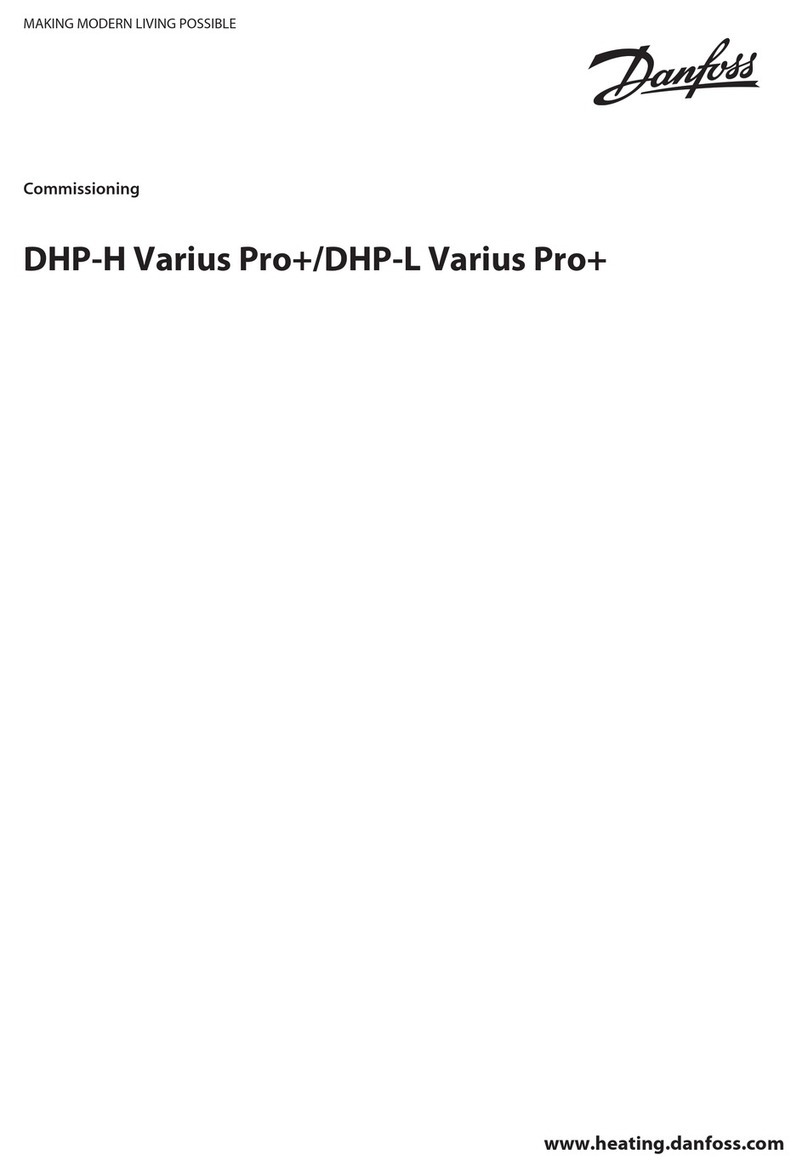
Danfoss
Danfoss DHP-H Varius Pro+ manual
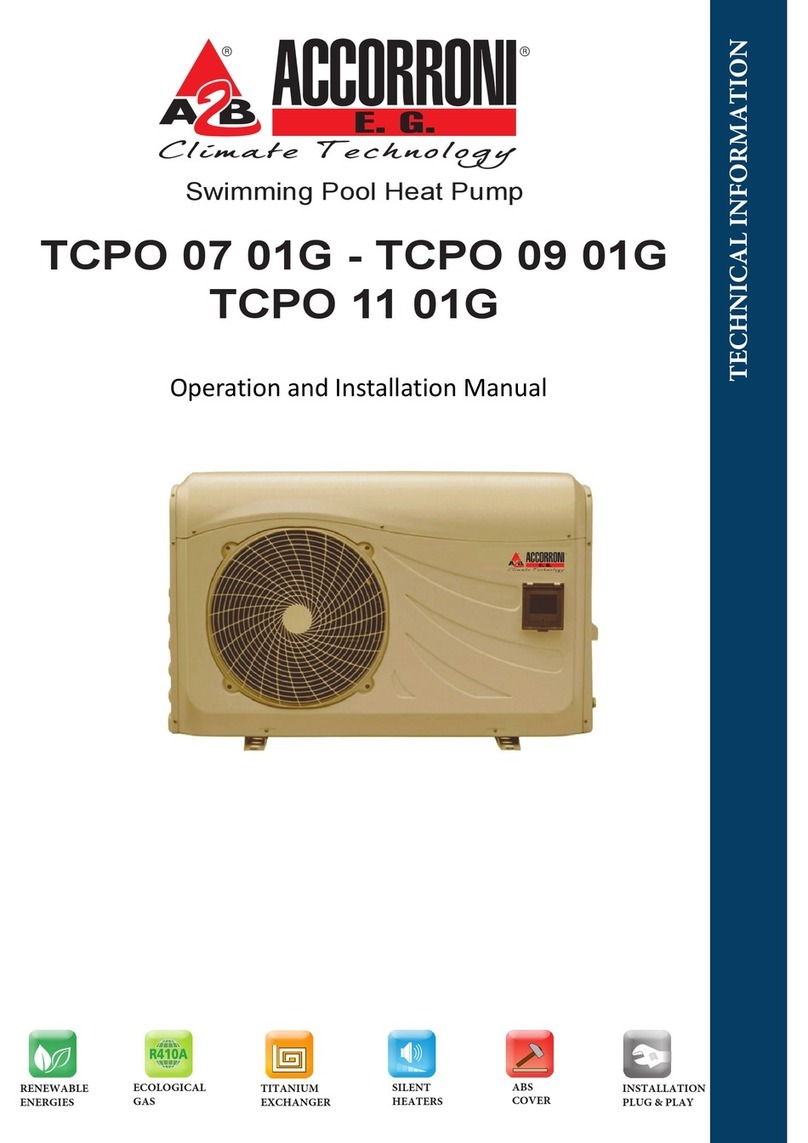
Accorroni
Accorroni S Series Operation and installation manual
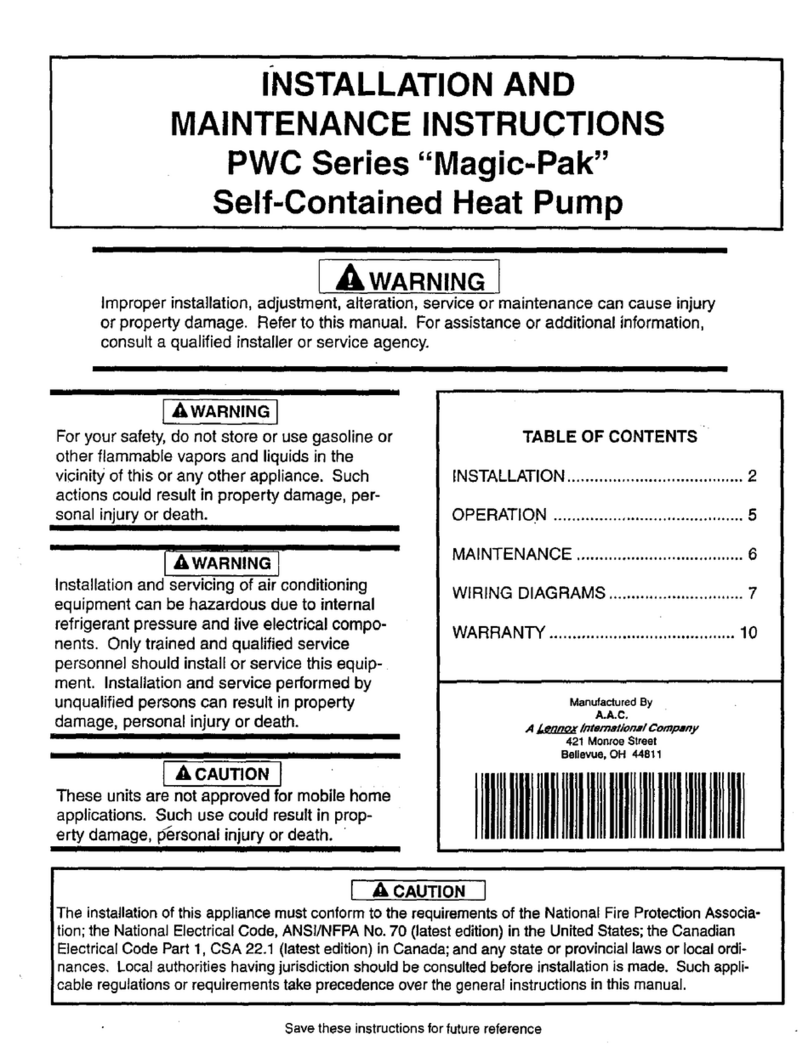
Lennox
Lennox Magic-Pak PWC182 Installation and maintenance instructions
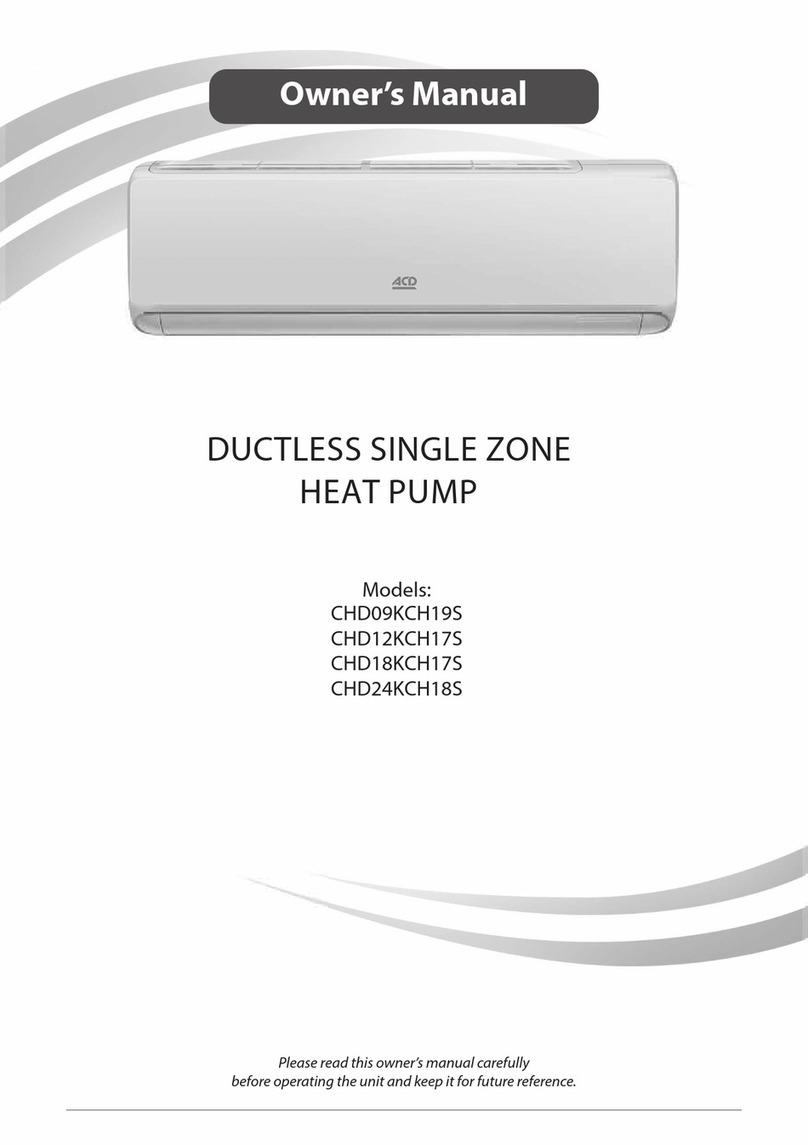
ACD
ACD CHD09KCH19S owner's manual

Dimplex
Dimplex LI 8MS Installation and operating instructions

Aquacal
Aquacal TropiCal quick start guide
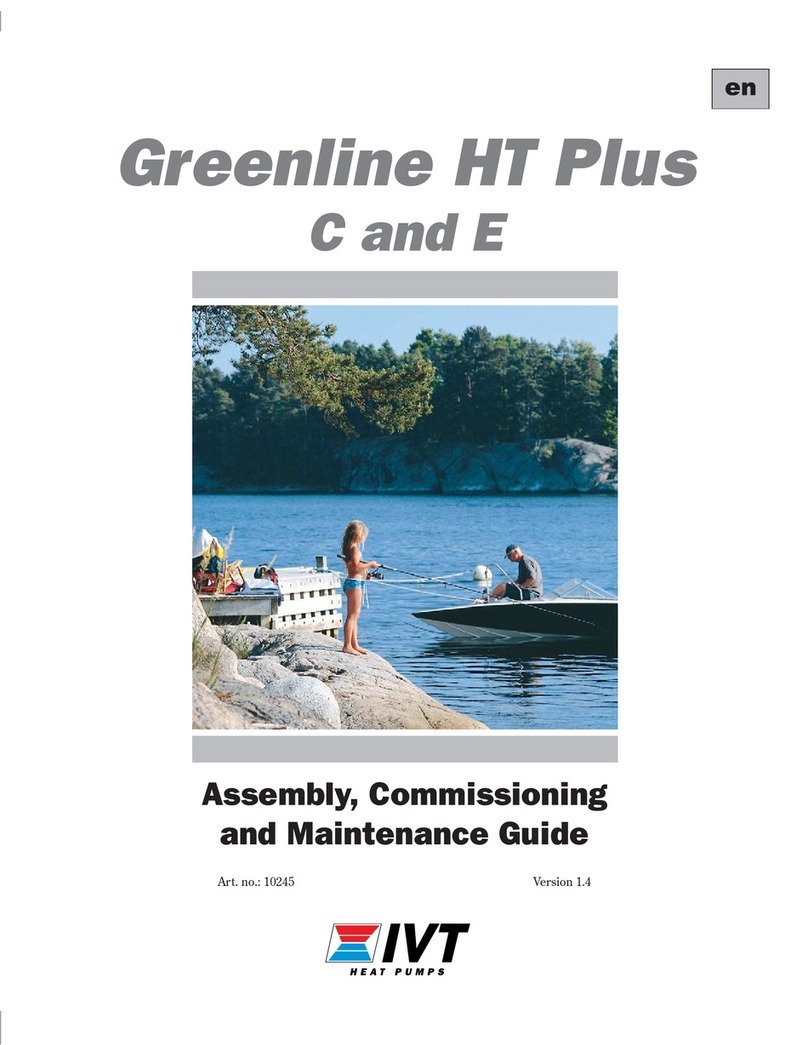
IVT
IVT Greenline HT Plus E Assembly, commissioning and maintenance guide
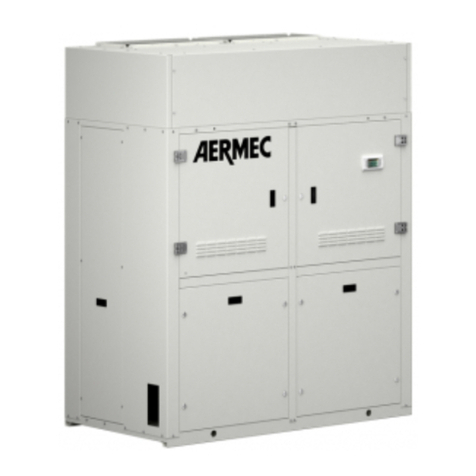
AERMEC
AERMEC NLC H installation manual
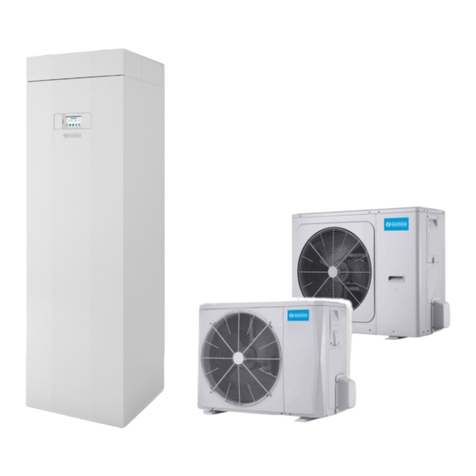
Olimpia splendid
Olimpia splendid Sherpa AQUADUE S3 E Instructions for installation, use and maintenance

AERMEC
AERMEC WRL Series manual

